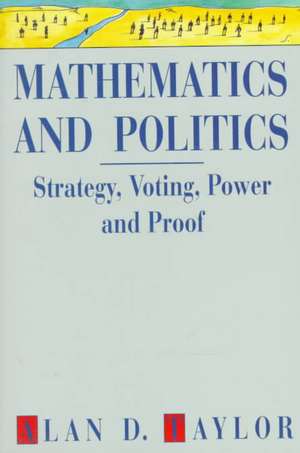Mathematics and Politics: Strategy, Voting, Power and Proof: Textbooks in Mathematical Sciences
Autor Alan D. Tayloren Limba Engleză Paperback – 9 mar 1995
Din seria Textbooks in Mathematical Sciences
- 17%
 Preț: 369.08 lei
Preț: 369.08 lei -
 Preț: 396.40 lei
Preț: 396.40 lei -
 Preț: 393.35 lei
Preț: 393.35 lei -
 Preț: 381.10 lei
Preț: 381.10 lei -
 Preț: 395.09 lei
Preț: 395.09 lei -
 Preț: 396.02 lei
Preț: 396.02 lei -
 Preț: 383.23 lei
Preț: 383.23 lei -

Preț: 297.30 lei
Nou
Puncte Express: 446
Preț estimativ în valută:
56.89€ • 60.83$ • 47.43£
56.89€ • 60.83$ • 47.43£
Carte indisponibilă temporar
Doresc să fiu notificat când acest titlu va fi disponibil:
Se trimite...
Preluare comenzi: 021 569.72.76
Specificații
ISBN-13: 9780387943916
ISBN-10: 0387943919
Pagini: 284
Ilustrații: XIV, 284 p.
Dimensiuni: 155 x 235 x 15 mm
Greutate: 0.44 kg
Ediția:New.
Editura: Springer
Colecția Springer
Seria Textbooks in Mathematical Sciences
Locul publicării:New York, NY, United States
ISBN-10: 0387943919
Pagini: 284
Ilustrații: XIV, 284 p.
Dimensiuni: 155 x 235 x 15 mm
Greutate: 0.44 kg
Ediția:New.
Editura: Springer
Colecția Springer
Seria Textbooks in Mathematical Sciences
Locul publicării:New York, NY, United States
Public țintă
Lower undergraduateCuprins
1 Escalation.- 1.1. Introduction.- 1.2. Game-Tree Analyses.- 1.3. Limitations and Back-of-the-Envelope Calculations.- 1.4. Statement of O’Neill’s Theorem.- 1.5. Conclusions.- Exercises.- 2 Conflict.- 2.1. Introduction.- 2.2. Dominant Strategies and Nash Equilibria.- 2.3. Prisoner’s Dilemma.- 2.4. A Game-Theoretic Model of the Arms Race.- 2.5. Chicken.- 2.6. Game-Theoretic Models of the Cuban Missile Crisis.- 2.7. Conclusions.- Exercises.- 3 Yes-No Voting.- 3.1. Introduction.- 3.2. Swap Robustness and the Nonweightedness of the Federal System.- 3.3. Trade Robustness and the Nonweightedness of the Procedure to Amend the Canadian Constitution.- 3.4. Statement of the Characterization Theorem.- 3.5. Conclusions.- Exercises.- 4 Political Power.- 4.1. Introduction.- 4.2. The Shapley-Shubik Index of Power.- 4.3. Calculations for the European Economic Community.- 4.4. A Theorem on Voting Blocs.- 4.5. The Banzhaf Index of Power.- 4.6. Two Methods of Computing Banzhaf Power.- 4.7. Ordinal Power: Incomparability.- 4.8. Conclusions.- Exercises.- 5 Social Choice.- 5.1. Introduction.- 5.2. Five Examples of Social Choice Procedures.- 5.3. Four Desirable Properties of Social Choice Procedures.- 5.4. Positive Results—Proofs.- 5.5. Negative Results—Proofs.- 5.6. The Condorcet Voting Paradox.- 5.7. A Glimpse of Impossibility.- 5.8. Conclusions.- Exercises.- 6 More Escalation.- 6.1. Introduction.- 6.2. Statement of the Strong Version of O’Neill’s Theorem.- 6.3. Proof (by Mathematical Induction) of the Strong Version of O’Neill’s Theorem.- 6.4. Vickrey Auctions.- 6.5. Vickrey Auctions as a Generalized Prisoner’s Dilemma.- 6.6. Conclusions.- Exercises.- 7 More Conflict.- 7.1. Introduction.- 7.2. The Yom Kippur War.- 7.3. The Theory of Moves.- 7.4. Models of Deterrence.-7.5. A Probabilistic Model of Deterrence.- 7.6. Two-Person Zero-Sum Games.- 7.7. Conclusions.- Exercises.- 8 More Yes-No Voting.- 8.1. Introduction.- 8.2. A Magic Square Voting System.- 8.3. Dimension Theory and the U.S. Federal System.- 8.4. Vector-Weighted Voting Systems.- 8.5. Conclusions.- Exercises.- 9 More Political Power.- 9.1. Introduction.- 9.2. The Johnston Index of Power.- 9.3. The Deegan-Packel Index of Power.- 9.4. The Power of the President.- 9.5. Ordinal Power: Comparability.- 9.6. The Chair’s Paradox.- 9.7. Conclusions.- Exercises.- 10 More Social Choice.- 10.1. Introduction.- 10.2. Social Welfare Functions.- 10.3. May’s Theorem for Two Alternatives.- 10.4. Arrow’s Impossibility Theorem.- 10.5. Single Peakedness—Theorems of Black and Sen.- 10.6. Conclusions.- Exercises.- Attributions.- References.
